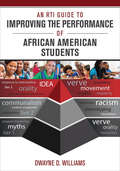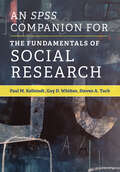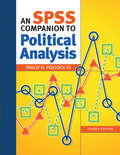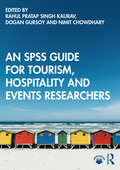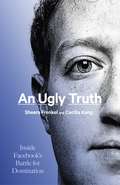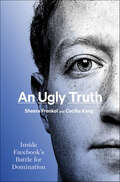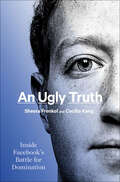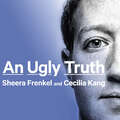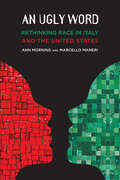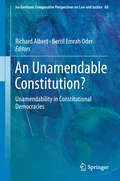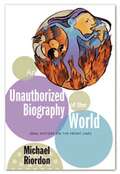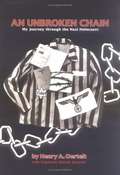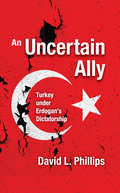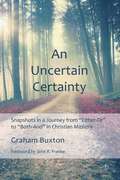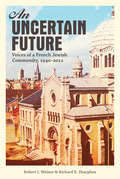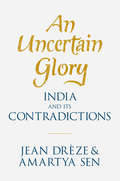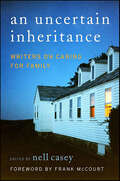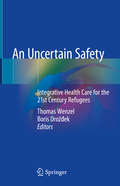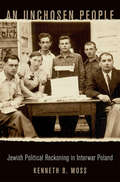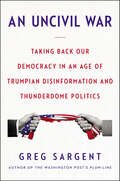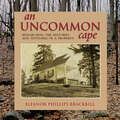- Table View
- List View
An RTI Guide to Improving the Performance of African American Students
by Dwayne D. WilliamsHelp students thrive with this systematic approach to culturally responsive instruction! Research shows that students of color learn best in classrooms that reflect their cultural values. This breakthrough book shows educators how to create culturally relevant RTI models that help diverse students thrive! Step-by-step, you’ll learn to skillfully apply 4 core characteristics critical to culturally responsive instruction: communalism, movement expressiveness, orality, and verve. Richly detailed case studies and evidence-based, process-focused strategies will help you to: Understand how and why culture mediates learning Dispel cultural biases and appreciate the assets among all student groups Address all tiers of the RTI model across grade levels Eliminate disproportionality in special education eligibility decisions Work collaboratively with African American parents and communities Use this thought-provoking handbook to confidently design high quality, culturally responsive instruction that fits the cultural needs of most African-American students! "All educators working with diverse students should read this book! Using personal experiences, the author provides examples of culturally responsive classroom instruction that brings tears to my eyes realizing what I missed in my own education." —Julie Esparza Brown, Assistant Professor in Special Education Portland State University "Diversity in race and culture is one of the greatest issues facing students and teachers in education today. Without changing our mindset and understanding how others learn, we will never meet the expectations of educating all people. This book is outstanding in addressing these issues. It is truly a powerful read and something all educators should keep as a resource when making decisions for students who do not fall into that stereotypical ′box′." —Cindy Lawrence, Curriculum Coordinator Lumberton ISD "This book presents salient and provocative ideas with regards to teaching the way students learn. These ideas are not readily spoken about in teacher preparation programs or in schools. This book provides an avenue to discuss the ways African American students learn best." —Lydia Adegbola, Assistant Principal NYC Department of Education
An RTI Guide to Improving the Performance of African American Students
by Dwayne D. WilliamsHelp students thrive with this systematic approach to culturally responsive instruction! Research shows that students of color learn best in classrooms that reflect their cultural values. This breakthrough book shows educators how to create culturally relevant RTI models that help diverse students thrive! Step-by-step, you’ll learn to skillfully apply 4 core characteristics critical to culturally responsive instruction: communalism, movement expressiveness, orality, and verve. Richly detailed case studies and evidence-based, process-focused strategies will help you to: Understand how and why culture mediates learning Dispel cultural biases and appreciate the assets among all student groups Address all tiers of the RTI model across grade levels Eliminate disproportionality in special education eligibility decisions Work collaboratively with African American parents and communities Use this thought-provoking handbook to confidently design high quality, culturally responsive instruction that fits the cultural needs of most African-American students! "All educators working with diverse students should read this book! Using personal experiences, the author provides examples of culturally responsive classroom instruction that brings tears to my eyes realizing what I missed in my own education." —Julie Esparza Brown, Assistant Professor in Special Education Portland State University "Diversity in race and culture is one of the greatest issues facing students and teachers in education today. Without changing our mindset and understanding how others learn, we will never meet the expectations of educating all people. This book is outstanding in addressing these issues. It is truly a powerful read and something all educators should keep as a resource when making decisions for students who do not fall into that stereotypical ′box′." —Cindy Lawrence, Curriculum Coordinator Lumberton ISD "This book presents salient and provocative ideas with regards to teaching the way students learn. These ideas are not readily spoken about in teacher preparation programs or in schools. This book provides an avenue to discuss the ways African American students learn best." —Lydia Adegbola, Assistant Principal NYC Department of Education
An SPSS Companion for The Fundamentals of Social Research
by Paul M. Kellstedt Guy D. Whitten Steven A. TuchAn SPSS Companion for The Fundamentals of Social Research offers students the opportunity to delve into the world of SPSS using real data sets and statistical analysis techniques directly from Paul M. Kellstedt, Guy D. Whitten, and Steven A. Tuch's new textbook. Workbook sections parallel chapters in the main text, giving students a chance to apply the lessons and techniques learned in each chapter in a statistical software setting. Detailed chapters teach students to reproduce results presented in the textbook, allowing them to become comfortable performing statistical analyses for evaluating causal claims through repeated practice. Step-by-step instructions for using SPSS are provided, along with command lines and screenshots to demonstrate proper use of the software. Instructions for producing the figures and tables in the main text are integrated throughout the workbook. End-of-chapter exercises encourage students to formulate and evaluate their own hypotheses.
An SPSS Companion to Political Analysis
by Philip H. PollockIn this much-anticipated revision of Pollock's popular SPSS workbook, students dive headfirst into actual political data and work with a software tool that prepares them for future political science research. Students learn by doing with guided examples, more than 120 screenshots, and step-bystep instructions.
An SPSS Guide for Tourism, Hospitality and Events Researchers
by Dogan Gursoy Rahul Pratap Singh Kaurav Nimit ChowdharyThis is the first book to provide the student of tourism, hospitality and events with all that they need to undertake statistical analysis using SPSS for research in their industry. Employing examples directly from the tourism, hospitality and events sector, it provides a comprehensive explanation on how appropriate statistical tools and methods can be identified for this research context and provides a step-by-step demonstration on how to carry out the chosen statistical operations. Each chapter opens with a sector-specific case study reflecting current research trends and issues from a range of different countries that are affecting the industry today. It is followed by an examination of the SPSS procedures relating to the case study and various solutions are offered. The implementation of clear, step-by-step demonstrations on how to carry out statistical operations using a combination of screenshots, diagrams, and tables aids the reader’s understanding. Chapters close with thorough guidance on how to appropriately write up interpretations of the research in a report. Research implications and recommendations for tourism and hospitality businesses are also provided, to enable them to successfully create and manage research strategies in action. Adopting an interdisciplinary perspective and written by a range of industry experts from all over the globe, this book will be essential for all students and researchers in the field of tourism, hospitality, and events as well as all those in related fields with an interest in statistical data analysis.
An Ugly Truth: Inside Facebook's Battle for Domination
by Sheera Frenkel Cecilia Kang'The ultimate takedown' New York Times'The problem of Facebook is Zuckerberg. And the question posed by this splendid book is: what are we going to do about him?' Observer'A comprehensive account . . . drawn from first-hand testimonies. Thoroughly engaging' The Times'What marks this book out is how it gets under the corporate bonnet . . . to build a picture of astounding corporate arrogance and irresponsibility' Sunday Times'An explosive new book' Daily Mail__________________________________________Award-winning New York Times reporters Sheera Frenkel and Cecilia Kang unveil the tech story of our times in a riveting, behind-the-scenes exposé that offers the definitive account of Facebook's fall from grace. Once one of Silicon Valley's greatest success stories, for the past five years, Facebook has been under constant fire, roiled by controversies and crises. It turns out that while the tech giant was connecting the world, they were also mishandling users' data, allowing the spread of fake news, and the amplification of dangerous, polarising hate speech. Critics framed the narrative as the irreconcilable conflict between the platform's lofty mission to advance society by bringing people together while also profiting off of them. The company, many said, had simply lost its way. But the truth is far more complex. Drawing on their unrivalled sources, Frenkel and Kang take readers inside the complex court politics, alliances and rivalries within the company, its growing political influence as well as its skirmishes with privacy groups and the FTC, to shine a light on the fatal cracks in the architecture of the tech behemoth. Their explosive, exclusive reporting led them to a shocking conclusion: The missteps of the last five years were not an anomaly but an inevitability - this is how the platform was built to perform. In a period of great upheaval, growth has remained the one constant under the leadership of Mark Zuckerberg and Sheryl Sandberg. Each has stood by as their technology is co-opted by hate-mongers, criminals and corrupt political regimes across the globe, with devastating consequences. In An Ugly Truth, they are at last held accountable.
An Ugly Truth: Inside Facebook's Battle for Domination
by Sheera Frenkel Cecilia KangThe award-winning insiders’ account of the scandals and toxic culture at Facebook—“thorough, high-caliber investigative reporting” (Kirkus, starred review).In An Ugly Truth, New York Times reporters Sheera Frenkel and Cecilia Kang present a behind-the-scenes exposé of Facebook’s fall from grace. They reveal explosive details about how the tech giant set out to connect the world—while also mishandling users’ data, spreading fake news, and amplifying dangerous, polarizing hate speech. The company, many said, had simply lost its way. But the truth is far more complex. Facebook’s engineers were instructed to create tools that encouraged people to spend as much time on the platform as possible, even if that meant promoting inflammatory rhetoric, conspiracy theories, and partisan filter bubbles. And while consumers and lawmakers were outraged by privacy breaches and misinformation, Facebook solidified its role as the world’s most voracious data-mining machine, posting record profits, and shoring up its dominance via aggressive lobbying efforts.Drawing on their unrivaled sources, Frenkel and Kang take readers inside the alliances and rivalries within the company to demonstrate that the company’s “missteps” were no such thing—this is how Mark Zuckerberg and Sheryl Sandberg built Facebook to perform. In An Ugly Truth, they are at last held accountable. A Book of the Year: Fortune, Foreign Affairs, The Times (London), Cosmopolitan, TechCrunch, WIRED
An Ugly Truth: Inside Facebook's Battle for Domination
by Sheera Frenkel Cecilia KangA riveting New York Times–bestselling exposé of Facebook’s fall from grace.Facebook has been under constant fire for the past five years, roiled by controversies and crises. As the tech giant was connecting the world, it was also mishandling users’ data, spreading fake news, and amplifying dangerous, polarizing hate speech—while relentlessly pursuing growth.The company, many said, had simply lost its way. But the truth is far more complex. Mark Zuckerberg and Sheryl Sandberg, held up as archetypes of uniquely twenty-first-century executives, attempted to deflect attention from the crises. And while consumers and lawmakers focused their outrage on privacy breaches and misinformation, Facebook solidified its role as the world’s most voracious data-mining machine, posting record profits and shoring up its dominance via aggressive lobbying efforts.Drawing on their unrivaled sources, award–winning New York Times reporters Sheera Frenkel and Cecilia King unravel the tech behemoth’s complex politics, alliances, and rivalries to expose the fatal cracks in its architecture. They reveal how its missteps were not an anomaly but an inevitability—this is how Facebook was built to perform.WINNER OF THE SABEW BEST IN BUSINESS AWARDA Book of the Year: Fortune, Foreign Affairs, The Times (London), Cosmopolitan, TechCrunch, WIRED
An Ugly Truth: Inside Facebook's Battle for Domination (Language Acts and Worldmaking #29)
by Sheera Frenkel Cecilia Kang'The ultimate takedown' New York Times'The problem of Facebook is Zuckerberg. And the question posed by this splendid book is: what are we going to do about him?' Observer'A comprehensive account . . . drawn from first-hand testimonies. Thoroughly engaging' The Times'What marks this book out is how it gets under the corporate bonnet . . . to build a picture of astounding corporate arrogance and irresponsibility' Sunday Times'An explosive new book' Daily Mail__________________________________________Award-winning New York Times reporters Sheera Frenkel and Cecilia Kang unveil the tech story of our times in a riveting, behind-the-scenes exposé that offers the definitive account of Facebook's fall from grace. Once one of Silicon Valley's greatest success stories, for the past five years, Facebook has been under constant fire, roiled by controversies and crises. It turns out that while the tech giant was connecting the world, they were also mishandling users' data, allowing the spread of fake news, and the amplification of dangerous, polarising hate speech. Critics framed the narrative as the irreconcilable conflict between the platform's lofty mission to advance society by bringing people together while also profiting off of them. The company, many said, had simply lost its way. But the truth is far more complex. Drawing on their unrivalled sources, Frenkel and Kang take readers inside the complex court politics, alliances and rivalries within the company, its growing political influence as well as its skirmishes with privacy groups and the FTC, to shine a light on the fatal cracks in the architecture of the tech behemoth. Their explosive, exclusive reporting led them to a shocking conclusion: The missteps of the last five years were not an anomaly but an inevitability - this is how the platform was built to perform. In a period of great upheaval, growth has remained the one constant under the leadership of Mark Zuckerberg and Sheryl Sandberg. Each has stood by as their technology is co-opted by hate-mongers, criminals and corrupt political regimes across the globe, with devastating consequences. In An Ugly Truth, they are at last held accountable.
An Ugly Word: Rethinking Race in Italy and the United States
by Ann Morning Marcello ManeriScholars and politicians often assume a significant gap between the ways that Americans and Europeans think about race. According to this template, in the U.S. race is associated with physical characteristics, while in Western Europe race has disappeared, and discrimination is based on insurmountable cultural differences. However, little research has addressed how average Americans and Europeans actually think and talk about race. In An Ugly Word, sociologists Ann Morning and Marcello Maneri examine American and Italian understandings of group difference in order to determine if and how they may differ. Morning and Maneri interviewed over 150 people across the two countries about differences among what they refer to as “descent-based groups.” Using this concept allowed them to sidestep the language of “race” and “ethnicity,” which can be unnecessarily narrow, poorly defined, or even offensive to some. Drawing on these interviews, the authors find that while ways of speaking about group difference vary considerably across the Atlantic, underlying beliefs about it do not. The similarity in American and Italian understandings of difference was particularly evident when discussing sports. Both groups relied heavily on traditional stereotypes of Black physicality to explain Black athletes’ overrepresentation in sports like U.S. football and their underrepresentation in sports like swimming – contradicting the claims that a biological notion of race is a distinctly American phenomenon. While American and Italian concepts of difference may overlap extensively, they are not identical. Interviews in Italy were more likely to reveal beliefs about groups’ innate, unchangeable temperaments, such as friendly Senegalese and dishonest Roma. And where physical difference was seen by Italians as superficial and unimportant, cultural difference was perceived as deeply meaningful and consequential. In contrast, U.S. interviewees saw cultural difference as supremely malleable—and often ascribed the same fluidity to racial identity, which they believed stemmed from culture as well as biology. In light of their findings, Morning and Maneri propose a new approach to understanding cross-cultural beliefs about descent-based difference that includes identifying the traits people believe differentiate groups, how they believe those traits are acquired, and whether they believe these traits can change. An Ugly Word is an illuminating, cross-national examination of the ways in which people around the world make sense of race and difference.
An Unamendable Constitution?: Unamendability In Constitutional Democracies (Ius Gentium: Comparative Perspectives on Law and Justice #68)
by Richard Albert Bertil Emrah OderThis book examines the subject of constitutional unamendability from comparative, doctrinal, empirical, historical, political and theoretical perspectives. It explores and evaluates the legitimacy of unamendability in the various forms that exist in constitutional democracies.Modern constitutionalism has given rise to a paradox: can a constitutional amendment be unconstitutional? Today it is normatively contested but descriptively undeniable that a constitutional amendment—one that respects the formal procedures of textual alteration laid down in the constitutional text—may be invalidated for violating either a written or unwritten constitutional norm. This phenomenon of an unconstitutional constitutional amendment traces its political foundations to France and the United States, its doctrinal origins to Germany, and it has migrated in some form to all corners of the democratic world. One can trace this paradox to the concept of constitutional unamendability. Constitutional unamendability can be understood as a formally entrenched provision(s) or an informally entrenched norm that prohibits an alteration or violation of that provision or norm. An unamendable constitutional provision is impervious to formal amendment, even with supermajority or even unanimous agreement from the political actors whose consent is required to alter the constitutional text. Whether or not it is enforced, and also by whom, this prohibition raises fundamental questions implicating sovereignty, legitimacy, democracy and the rule of law.
An Unauthorized Biography of the World: Oral History on the Front Lines
by Michael RiordonAn Unauthorized Biography of the World explores the practice of engaged oral history: the difficult, sometimes dangerous work of recovering fragments of human story that have gone missing from the official versions. Michael Riordon has thirty years’ experience as a writer and broadcaster in the field. Readers will encounter a gallery of brave, passionate people who gather silenced voices and lost life stories. The canvas is broad, the stakes are high: the battles for First Nations lands in Canada; environmental justice in Chicago; genocide in Peru; homeless people organizing in Cleveland; September 11/01, and after, in New York City; gay survivors of electroshock in Britain; the struggle to preserve a people’s identity in Newfoundland; peasant resistance to a huge transnational gold mine in Turkey.
An Unbiased Appraisal of Purchasing Power Parity
by Paul Cashin C. John McdermottA report from the International Monetary Fund.
An Unbreakable Cycle:Drug Dependency Treatment, Mandatory Confinement, and HIV/AIDS in China’s Guangxi Province
by Human Rights WatchIn China, illicit drug use is an administrative offense and Chinese law dictates that drug users "must be rehabilitated." In reality, police raids on drug users often drive them underground, away from methadone clinics, needle exchange sites, and other proven HIV prevention services. And every year Chinese police send tens of thousands of drug users to mandatory drug treatment centers, often for years, without trial or due process. This report finds that most mandatory treatment centers, while ostensibly meant to provide drug treatment, do not actually offer forms of drug dependence treatment internationally recognized as effective. Mostly, drug users are forced to work or to spend their days in crowded cells little different from prisons.
An Unbroken Chain: My Journey through the Nazi Holocaust
by Henry A. Oertelt Stephanie Oertelt SamuelsIn this amazing true-life account of the Holocaust, Henry Oertelt retraces the sequence of events that forever changed his destiny. Each event is broken down into eighteen separate incidents, all intrinsically linked to form the Chain of Life that kept him alive. Although often shocking, the remarkable events of Henry's life will touch the lives and hearts of readers everywhere.
An Uncensored Walk Through the Bible
by Linda HahnThis book is in no way a scholastic writing intended to impress the educated of theological institutes. Nor has it been written for the critics of the Bible. It contains no preaching. It does not promote any specific doctrine of any specific denomination in any part of the world. It is the Bible speaking for itself.
An Uncertain Ally: Turkey under Erdogan's Dictatorship
by David L. PhillipsUnder the rule of Recep Tayyip Erdogan Turkey has descended into a dictatorship, promotes the Islamist agenda, abuses human rights, limits freedom of expression in the press, and wages war against the Kurds. While Turkey has historically been important geopolitically, it has become an outlier in Europe and an uncertain ally of the United States. An Uncertain Ally is a straightforward indictment of Erdogan. Drawing on inside sources in his Justice and Development Party (AKP) and the police, the book reveals corruption and money laundering schemes that benefitted Erdogan, his cronies, and family members. Erdogan has polarized Turkish society and created conditions that led to the coup attempt of July 2016. He has also deepened divisions by accusing Fethullah Gulen, an Islamic teacher in Pennsylvania, of establishing a parallel state and masterminding the coup attempt. Erdogan has seized on the failed coup to justify a witch hunt, arresting thousands and ordering the wholesale dismissal of alleged coup sympathizers. Rather than foster reconciliation, he pursued vendettas and turned Turkey into a gulag. An Uncertain Ally exposes Turkey’s ties to jihadists in Syria and the Islamic State, questioning its suitability as a NATO member. Under Erdogan, Turkey faces a dark future that poses a danger to the region and internationally.
An Uncertain Certainty: Snapshots in a Journey from 'Either-Or' to 'Both-And' in Christian Ministry
by Graham BuxtonMany people in Christian ministry are tired of simplistic certainties; what they need is permission to live with uncertainty, with mystery, ambiguity, and paradox. Because we live in a world that is far removed from the modernist version of reality,with its rational, clinical, and superficial presentation of life, we need the courage and wisdom to embrace the presence of uncertainties in the midst of certainty. In this book, the author offers snapshots of a number of central Christian topics-God, the gospel, the church, salvation, ministry-inviting us to treat them as features of a landscape to explore rather than a set of propositional statements to sign up to. Each chapter-short enough to provoke interest and curiosity-will be a catalyst for deeper reflection and enquiry, inviting us to discover a new freedom in ministry as we embrace a more generous both-and perspective in place of a more narrow either-or interpretation of the Christian faith. In the process, we may find ourselves rediscovering the Life we have lost in living as we imaginatively participate in the life, ministry, and mystery of the triune God of grace in our midst.
An Uncertain Future: Voices Of A French Jewish Community, 1940-2012
by Robert I. Weiner Richard E. SharplessThis contemporary oral history, based on interviews conducted over an 18-year period, is the first of its kind in English. The interviews, some repeated with the same subjects over years, demonstrate how the Jewish community of Dijon has evolved over time in response to challenges both internal and external. The authors provide an introduction to the series of interviews as well as a detailed history of the community. A chronology, a map of Dijon, and photos of many interviewees are included. The book also provides an update on recent events in the community, a suggested reading list, and a bibliography.
An Uncertain Glory: India and its Contradictions
by Amartya Sen Jean DrèzeWhy India's problems won't be solved by rapid economic growth aloneWhen India became independent in 1947 after two centuries of colonial rule, it immediately adopted a firmly democratic political system, with multiple parties, freedom of speech, and extensive political rights. The famines of the British era disappeared, and steady economic growth replaced the economic stagnation of the Raj. The growth of the Indian economy quickened further over the last three decades and became the second fastest among large economies. Despite a recent dip, it is still one of the highest in the world.Maintaining rapid as well as environmentally sustainable growth remains an important and achievable goal for India. In An Uncertain Glory, two of India's leading economists argue that the country's main problems lie in the lack of attention paid to the essential needs of the people, especially of the poor, and often of women. There have been major failures both to foster participatory growth and to make good use of the public resources generated by economic growth to enhance people's living conditions. There is also a continued inadequacy of social services such as schooling and medical care as well as of physical services such as safe water, electricity, drainage, transportation, and sanitation. In the long run, even the feasibility of high economic growth is threatened by the underdevelopment of social and physical infrastructure and the neglect of human capabilities, in contrast with the Asian approach of simultaneous pursuit of economic growth and human development, as pioneered by Japan, South Korea, and China.In a democratic system, which India has great reason to value, addressing these failures requires not only significant policy rethinking by the government, but also a clearer public understanding of the abysmal extent of social and economic deprivations in the country. The deep inequalities in Indian society tend to constrict public discussion, confining it largely to the lives and concerns of the relatively affluent. Drèze and Sen present a powerful analysis of these deprivations and inequalities as well as the possibility of change through democratic practice.
An Uncertain Inheritance: Writers on Caring for Ill Family Members
by Nell CaseyIn this eloquent collection of essays—from the editor of the national bestseller Unholy Ghost: Writers on Depression—contributors reveal their experiences in caring for family through illness and deathToday, thirty million people look after frail family members in their own homes. This number will increase drastically over the next decade—as baby boomers tiptoe toward old age; as soldiers return home from war wounded, mentally and physically; as a growing number of Americans find themselves caught between the needs of elderly parents and young children; as medical advances extend lives and health insurance fails to cover them. This compelling book offers both literary solace and guidance to the people who find themselves witness to—and participants in—the fading lives of their intimates.Some of the country's most accomplished writers offer frank insights and revelations about this complex relationship. Julia Glass describes the tension between giving care—to her two young sons—and needing care after being diagnosed with breast cancer; Ann Harleman explores her decision to place her husband in an institution; Sam Lipsyte alternates between dark humor and profound understanding in telling the story of his mother's battle with cancer; Ann Hood wishes she'd had more time as a caregiver, to prepare herself for the loss of her daughter; Andrew Solomon examines the humbling experience of returning as an adult to be cared for by his father; cartoonist Stan Mack offers an illustrated piece about the humor and hell of making his way through the medical bureaucracy alongside his partner, Janet; Julia Alvarez writes about the competition between her and her three sisters to be the best daughter as they tend to their ailing parents. An Uncertain Inheritance examines the caregiving relationship from every angle—children caring for parents; parents caring for children; sib-lings, spouses, and close friends, all looking after one another—to reveal the pain, intimacy, and grace that take place in this meaningful connection.
An Uncertain Safety: Integrative Health Care for the 21st Century Refugees
by Thomas Wenzel Boris DrožđekThis book addresses the psychosocial and medical issues of forced migration due to war, major disasters and political as well as climate changes. The topics are discussed in the context of public health and linked to organizational, legal and practical strategies that can offer guidance to professionals, as well as governmental and non-governmental organizations. Both internal and international displacement present substantial challenges that require new solutions and integrated approaches. Issues covered include an overview of current health challenges in the new refugee crises: medicine and mental health in disaster areas, long-term displacement and mental health, integration of legal, medical, social and health economic issues, children and unaccompanied minors, ethical challenges in service provision, short and long-term issues in host countries, models of crises intervention, critical issues, such as suicide prevention, new basic and “minimal” intervention models adapted to limited resources in psychosocial and mental health care, rebuilding of health care in post-disaster/conflict countries, training and burn-out prevention. The book was developed in collaboration with the World Psychiatric Association, and is endorsed by Fabio Grandi (UN High Commissioner for Refugees), Manfred Nowak (former UN Special Rapporteur for Torture), and Jorge Aroche (President of IRCT).
An Unchosen People: Jewish Political Reckoning in Interwar Poland
by Kenneth B. MossA revisionist account of interwar Europe’s largest Jewish community that upends histories of Jewish agency to rediscover reckonings with nationalism’s pathologies, diaspora’s fragility, Zionism’s promises, and the necessity of choice. What did the future hold for interwar Europe’s largest Jewish community, the font of global Jewish hopes? When intrepid analysts asked these questions on the cusp of the 1930s, they discovered a Polish Jewry reckoning with “no tomorrow.” Assailed by antisemitism and witnessing liberalism’s collapse, some Polish Jews looked past progressive hopes or religious certainties to investigate what the nation-state was becoming, what powers minority communities really possessed, and where a future might be found—and for whom. The story of modern Jewry is often told as one of creativity and contestation. Kenneth B. Moss traces instead a late Jewish reckoning with diasporic vulnerability, nationalism’s terrible potencies, Zionism’s promises, and the necessity of choice. Moss examines the works of Polish Jewry’s most searching thinkers as they confronted political irrationality, state crisis, and the limits of resistance. He reconstructs the desperate creativity of activists seeking to counter despair where they could not redress its causes. And he recovers a lost grassroots history of critical thought and political searching among ordinary Jews, young and powerless, as they struggled to find a viable future for themselves—in Palestine if not in Poland, individually if not communally. Focusing not on ideals but on a search for realism, Moss recasts the history of modern Jewish political thought. Where much scholarship seeks Jewish agency over a collective future, An Unchosen People recovers a darker tradition characterized by painful tradeoffs amid a harrowing political reality, making Polish Jewry a paradigmatic example of the minority experience endemic to the nation-state.
An Uncivil War: Taking Back Our Democracy in an Age of Trumpian Disinformation and Thunderdome Politics
by Greg SargentHow we got here, how to fix it: “One of the sharpest-eyed observers of contemporary American politics . . . exposes the dismal roots of our current moment.” —Daniel Ziblatt, New York Times–bestselling coauthor of How Democracies DieIn An Uncivil War, the Washington Post’s Greg Sargent sounds an urgent alarm about the deeper roots of our democratic backsliding—and how to turn things around before it’s too late.American democracy is facing a crisis as fraught as we’ve seen in decades. Donald Trump’s presidency and rhetoric has raised the specter of authoritarian rule. Extreme polarization and the scorched-earth war between the parties drags on with no end in sight. At the heart of this dangerous moment is a paradox: It took a figure as uniquely menacing as Trump to rivet the nation’s attention on the fragility of our democracy. Yet the causes of our dysfunction are long-running—they predate Trump, helped facilitate his rise, and, distressingly, will outlast him.Sargent reveals why we’ve fallen into the ditch—and how to get out of it. Drawing upon years of research and reporting, he exposes the unparalleled sophistication and ambition of GOP tactics, including computer-generated gerrymandering, underhanded voter suppression, and ever-escalating legislative hardball. All of this has been accompanied by foreign-government intervention and an unprecedented level of political disinformation that threatens to undermine the very possibility of shared agreement on facts—and poses profound new challenges to the media’s ability to inform the citizenry. Yet the Republican Party is only part of the problem. As Sargent provocatively reveals, Democrats share culpability for helping to accelerate this slide.But our plight is far from hopeless, and Sargent offers a series of doable prescriptions for saving our democracy, including a shift of focus toward state legislatures, creative voter registration policies, innovative approaches to fairer districting, and a new sense of purpose. The result is “a probing, sophisticated, very readable discussion of constitutional flaws and economic and ideological antagonisms, one that will give readers a deeper understanding of America’s political rot” (Publishers Weekly).“The author’s explanation is crystal-clear, if alarming . . . a solid appeal to small-r republican virtues and an altogether readable polemic.” —Kirkus Reviews
An Uncommon Cape: Researching the Histories and Mysteries of a Property (Excelsior Editions)
by Eleanor Phillips BrackbillWhen Eleanor Phillips Brackbill bought her suburban Westchester house in 2000, three mysteries came with it. First, from the former owner, came the information that the 1930s house was "a Sears house or something like that." Thrilled to think it might be a Sears, Roebuck & Co. mail-order house, Brackbill was determined to find evidence to prove it. She found instead a house pedigree of a different sort.Second, and even more provocative, was the discovery of several iron stakes protruding from the property's enormous granite outcropping, bigger in square footage than the house itself. When queried about them, the former owner told her, "Someone a long time ago kept monkeys there, chained to the stakes." Monkeys? Was this some kind of suburban legend? A third mystery came to light at closing, when a building inspector's letter contained a reference to the house having had, at one time, a different address. Why would the house have had another address? Her curiosity aroused, and intent upon finding the facts, Brackbill gradually peeled back layers of history, allowing the house and the land to tell their stories, and uncovering a past inextricably woven into four centuries of American history. At the same time, she found thirty-two owners, across 350 years, who had just one thing in common: ownership of a particular parcel of land.An Uncommon Cape not only tells the story of an eight-year odyssey of fact-finding and speculation but also answers the broader question: "What came before?" and, through material presented in twenty-two sidebars, offers readers insights and guidelines on how to find the stories behind their own homes.
